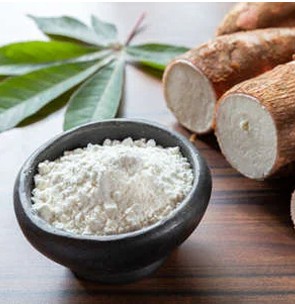

Published on Oct 06th, 2022

Tapioca is a gluten-intolerant starch obtained from the holding root of the cassava or yucca plant. Tapioca emerged in Brazil but is a usual diet found in numerous tropical countries globally. Historically, during World War II, several Southeast Asian countries lived fundamentally on tapioca.
Now, tapioca is available in assorted structures, such as pearls, flour, syrups, maltodextrin, syrup solids, and drink powder. Tapioca is opted as a thickener and is applicable in sauces, puddings, desserts, cereals, baby food, food and snacks, bread, bakery goods, and fruit pies. It carries a neutral flavor and solid gelling resource, making it fruitful as a thickening representative in sweet and savory meals. The texture of cooked tapioca is thick and sticky.
The organic tapioca starch can be accessible in both white and yellow diversities. White tapioca is more super than yellow tapioca. Yellow tapioca carries additional vitamins and minerals than its white fellow.
There are two types of organic tapioca starch that are within easy reach for consumers. The first one is acquired from the whole root, and the second is gained from the root’s inner part. The two have divergent uses and characteristics.
Organic products prepared with tapioca are liked by people, especially the syrups such as clarified tapioca syrup and tapioca low-sugar syrup.
Organic Clarified Tapioca Syrup is produced by the enzymatic conversion of tapioca starch and organic clarified enzymes put together into a translucent-colored sweetener with almost very low glucose content. These syrups keep slight sweetness, body, and viscosity.
Organic Tapioca Low Sugar Syrup provides a buttery, smooth, and savory taste. The preparation of this syrup is done through an enzymatic treatment of tapioca. This syrup carries a bit of a sweet buttery flavor and perfect choice for those who restrict honey and heavy syrups due to allergies.
The U.S. Department of Agriculture (USDA) provides nutrition details for a 100-gram serving (around 2/3 cup) of bare/dry tapioca pearls.
Calories: 358
Fat: 0.02g
Sodium: 1mg
Carbs: 88.7g
Fiber: 0.9g
Sugars: 3.35g
Protein: 0.2g
The above nutritional ratios clearly show that every age group can easily consume all sorts of tapioca. It is a rich essential root of carbohydrates as well.
As time passes, tapioca has become the eating habit of millions of people worldwide. But many of us don’t have enough knowledge regarding its health benefits. Let’s get it here today.
Dietary fiber is a plant integrant that can’t be absorbed or digested by the body. Fiber contributes highly to the well-being of the heart and digestive health. It helps to manage blood sugars and encourages a healthy weight.
The fiber figure is not so much, but the majority of people do not hold sufficient of it. Factually, the middle fiber consumption in the U.S is hardly 15 grams. The consumption rate is less than recommended to 25 to 38 grams daily. Due to this, fiber can easily be consumed in our daily meals through tapioca.

This magical ingredient presents many forms and is impressive in the supply of calcium, protein, and vitamin K. They are valuable to bone and muscle life. They turn the condition of your joints and limbs from lower to fit, active, and supple. Bone density and flexibility reduce with age, paving the way for conditions such as osteoporosis and osteoarthritis. To prevent ourselves from the miseries of bone health, we must include tapioca in our dietary schedule.
Tapioca has a small quantity of iron and copper, but as we all know, those little practical things make a big difference. These precious minerals are crucial for blood well-being. These minerals oppose diseases such as anemia by delivering proper circulation and sufficient oxygen.
Gluten is a protein that usually exists in grains like wheat, barley, and rye. Its intake can be injurious to people with diseases such as celiac disease. A gluten-intolerant diet also comforts people with irritable bowel syndrome. If you avoid gluten or are thinking of going on a zero-gluten diet plan, tapioca is a fantastic option to opt for.
The quantity of vitamin K present in tapioca outshines mental health. Vitamin K deducts the incidence of Alzheimer’s disease by sharpening brain neuronal performance. It also combats free radicals that may result in the spoiling of brain cells.
The fiber quantity is indeed the least in tapioca, but it can work to decrease upper cholesterol scales. This statement is true when we combine tapioca with fiber-oriented sources like whole grains, legumes, fresh fruit, and veggies. Gaining and balancing a satisfied cholesterol word count deducts the danger of heart diseases such as heart attack and stroke. Tapioca also carries iron, a mineral must-have for developing red blood cells so oxygen can be given out all over the body. It makes the availability of folic acid as well. It is also identified as folate; folic acid serves in the formation of red blood cells and all fresh cells for that purpose.
Tapioca is the root of resistant starch. Resistant starch goes by the small intestine without being digested. Rather, the starch is fermented in the large intestine, nourishing your healthy gut bacteria. Resistant starch made from tapioca is type 4, indicating that several chemical processes are utilized to make it indigestible.

The starch in tapioca has an amount of soluble fiber that fosters accurate digestion functionality. This sets it convenient for the body to hold vitamins and minerals. Consuming it in different ways makes our skin look younger and fresh. The great part about tapioca is that we can have it at any time for breakfast, lunch, dinner, and desserts. Moreover, desserts offer us a yummy treat, and we can easily customize them as per our mood.
Tapioca is considered the ingredient of well-being. Make sure to include it in your diet chart to expedite the positive effects on your physical and mental progress.
BackBe the first to know about new products, events and offers.